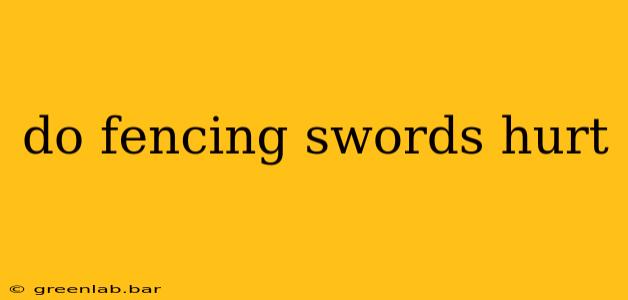Fencing, a sport demanding precision, agility, and strategy, often sparks the question: do fencing swords hurt? The short answer is: they can, but proper technique and safety precautions significantly minimize the risk. This article delves deeper into the potential for injury, the protective gear used, and how fencers mitigate the risks involved.
Understanding Fencing Swords and Their Construction
Fencing swords aren't designed to inflict serious damage. Instead, they're carefully crafted for controlled contact. There are three main types:
-
Foil: A light, thrusting weapon, the foil's point is the only scoring area. Its relatively flexible blade is designed to deflect blows, minimizing impact.
-
Épée: Similar to the foil in weight but stiffer, the épée allows for scoring with the entire blade. Again, its design prioritizes controlled contact over inflicting harm.
-
Sabre: The heaviest and most versatile, the sabre allows for cuts and thrusts to the upper body. Despite this, the blade's flexibility and the protective gear worn still greatly reduce the risk of serious injury.
Protective Gear: Your First Line of Defense
The protective gear in fencing is crucial in preventing injuries. This includes:
-
Mask: A sturdy wire mesh mask protects the face and head from accidental blows.
-
Jacket: A thick, padded jacket covers the torso, absorbing impacts from the blades.
-
Plastron (underjacket): This padded undergarment provides an extra layer of protection beneath the jacket.
-
Breeches/Pants: These offer protection for the legs, though injuries to the legs are less frequent due to the target areas of each weapon type.
-
Gloves: These cover the hand and wrist, protecting against accidental cuts and scrapes.
Proper use of this gear is non-negotiable. Without it, the risk of injury increases dramatically.
Types of Injuries and Their Likelihood
Despite the protective gear, injuries can still occur. These are typically:
-
Minor Cuts and Bruises: These are the most common injuries, often resulting from glancing blows or accidental contact outside the target area. Proper technique minimizes these occurrences.
-
Muscle Strains and Sprains: These can happen from the vigorous physical activity involved in fencing, regardless of blade contact.
-
Concussions (rare): Although the mask offers excellent protection, concussions are possible with exceptionally forceful impacts.
Serious injuries are rare in properly run and supervised fencing events. The overwhelming majority of injuries are minor and quickly heal.
Minimizing Risk: Technique and Training
Proper training and technique are paramount in injury prevention. Experienced coaches emphasize:
-
Controlled movements: Learning to control one's movements and weapon prevents reckless actions that could lead to injury.
-
Proper footwork: Good footwork is crucial for maintaining balance and minimizing risk of collisions.
-
Respect for opponents: Respectful conduct on the piste is key to ensuring a safe environment for all participants.
Conclusion: Fencing is Safe with Proper Precautions
While fencing swords can hurt if used improperly, the sport is inherently safe when practiced correctly. The protective gear, combined with proper training and technique, minimizes the risk of serious injury. Minor cuts and bruises are possible, but these are generally minor and easily managed. Therefore, with the right safety measures, fencing provides an exhilarating and rewarding experience for athletes of all skill levels.

